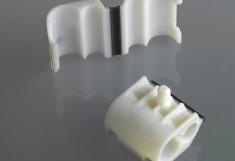PolyJet-Technology
Drucker-Spezifikationen
Model:
Objet260 Connex3
Construction volume:
255 × 252 × 200 mm
Layer thickness:
Horizontal layer thickness of 32 μm
resolution:
X axis: 600 dpi; Y axis: 600 dpi; Z axis: 1600 dpi
Accuracy:
20 to 85 μm for components smaller than 50 mm; up to 200 μm for full model size (only for solid materials, depending on geometry, print parameters and model orientation)
model materials
Materials:
Vero family of opaque materials, including:
- VeroGray (RGD850)
- VeroBlue (RGD840)
- VeroBlackPlus (RGD875)
- VeroCyan
- VeroMagenta
- VeroYellow
- VeroBlack
- VeroWhitePlus
- Vero PureWhite ist 20 Prozent heller als VeroWhitePlus und besitzt die doppelte Deckkraft
Digital materials:
Hundreds of composites can be made, including:
- Radiant mixed colors in solid and opaque
- Transparent colors
- Gummy/rubber-like materials with a variety of Shore A hardnesses
- Digital ABS for durability, including blends with rubber
- Polypropylene-like materials with improved heat resistance
Availability on request !
PolyJet-Technology
PolyJet 3D printing technology is a powerful additive process technology that makes it simple and reliable to produce extremely accurate and detailed models with accuracies of up to 0.1mm, amazingly smooth surfaces, thin walls and complex geometries. Depending on the type of printer, a wide variety of photopolymer resins (acrylic resins) ranging from solid to rubber-like, transparent or opaque, polypropylene-simulating, ABS-simulating and biocompatible are available, which allow an accurate and extremely realistic representation of the final product.
Der PolyJet-Process
PolyJet-based 3D printing uses up to eight printheads with multiple linear nozzles to apply very fine liquid photopolymer acrylic resin droplets in ultra-thin layers up to 0.016 mm (see 2D inkjet printer). Due to the small size of the droplets, even very fine details can be displayed. The printheads move along the X and Y axes and apply the model material and support material to the build platform at a resolution of 600 x 600 dpi. In the Z axis, the resolution is 900 or 1600 dpi, depending on the PolyJet ™ system and print mode. Each layer is fully cured by UV lamps attached to the printheads.
Appropriate software manages this process and independently calculates the support structures required to create overhangs and complex geometries. After each completed layer, the build platform travels down the Z axis one layer at a time and the next layer is sprayed directly onto the previous one. This results in fully cured models that can be used immediately after completion. The nontoxic support material does not interfere with the model material and can be removed automatically with a water jet device, or automatically using leachable support materials in a washout station.
In addition, the PolyJet 3D printing system of the Connex3 family has the unique PolyJet multi-material technology, which is the only 3D printing process in the world that enables simultaneous processing, combining and mixing of up to three different base materials.
The pre-established composites produced in this process are called digital materials. They have, depending on requirements, optimized coloring and / or mechanical properties. In addition, multi-component models with rubbery, solid and transparent components can be produced in one print.
The polyet- multi-material technology opens up almost unlimited possibilities to reproduce the optical, haptic and functional properties of the end products as closely as possible. In total, the PolyJet process has more than 20 different base materials and thousands of digital composites and mixed color shades with specific values in terms of tensile strength, elongation at break, temperature dimensional stability and Shore-A flexibility.





